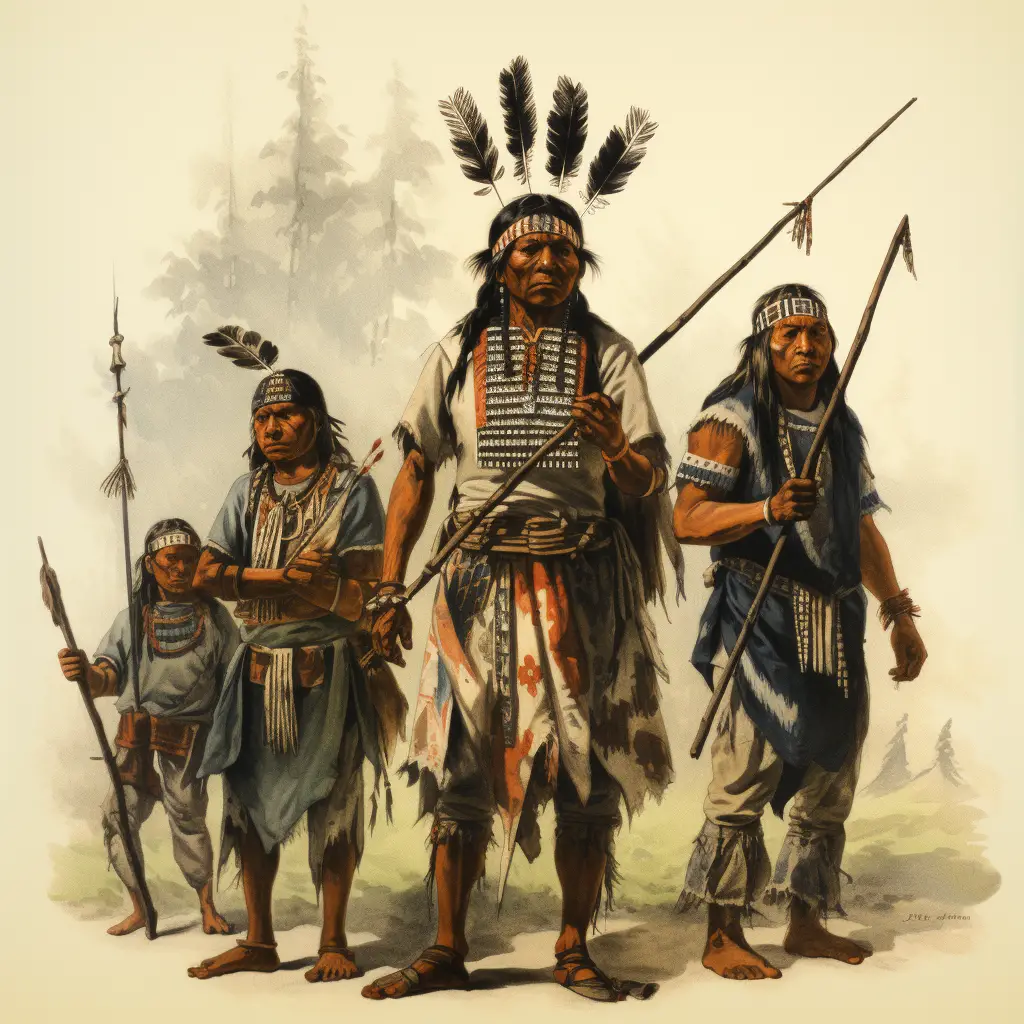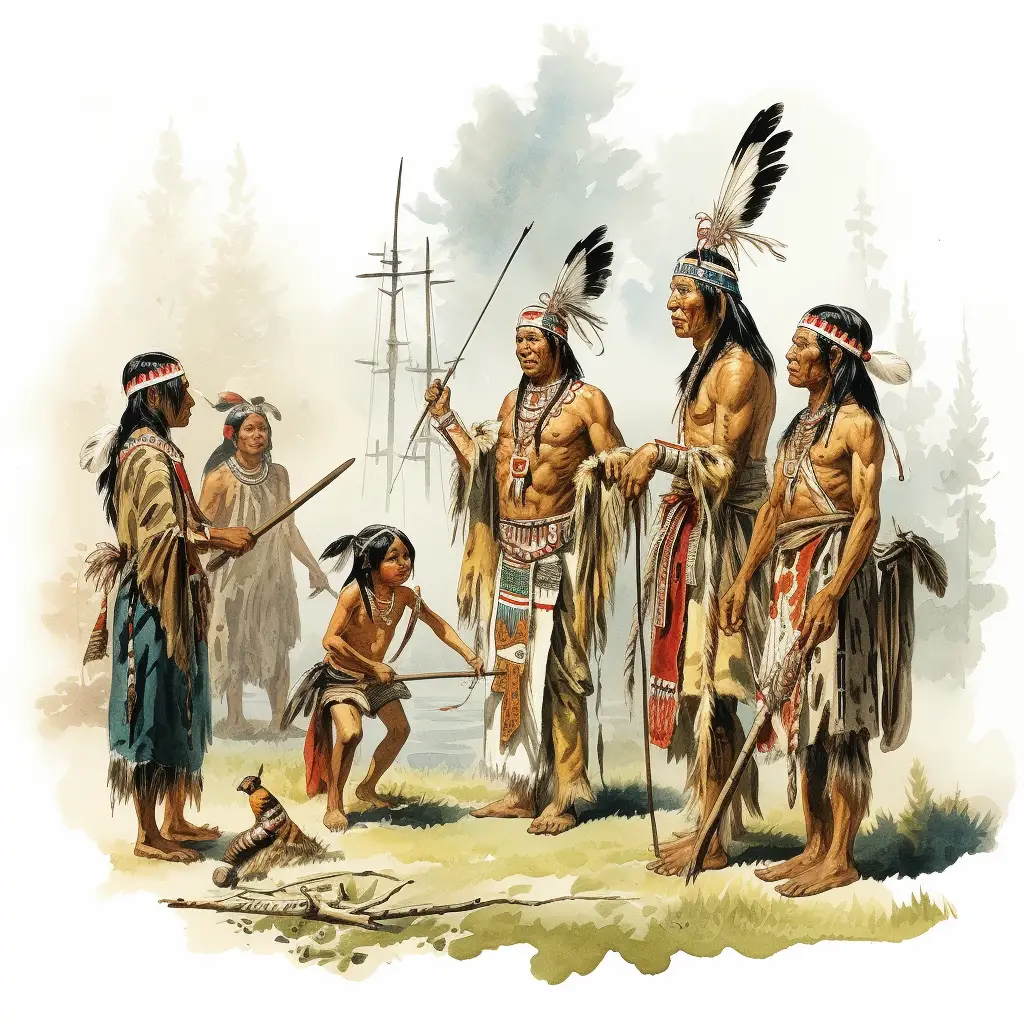Iroquois Tribe
The Iroquois tribe, also known as the Haudenosaunee, was a group of Native American people who inhabited the northeastern part of North America. They had a unique system of government known as the Iroquois Confederacy, which was a union of six different tribes.
The Iroquois were skilled farmers, hunters, and traders, and they played a significant role in the fur trade with European settlers. They also had a rich cultural and spiritual heritage, with a strong emphasis on community and harmony with nature. Today, the Iroquois continue to maintain their traditions and are recognized as sovereign nations within the United States.

Iroquois Tribe Facts for Kids
- Iroquois means “longhouse builders”.
- The Iroquois are also known as the Haudenosaunee.
- They lived in longhouses made from wood.
- Their diet included corn, beans, and squash.
- The Iroquois had a strong League of Five Nations.
- Their society was matriarchal and matrilineal.
- The Iroquois lived in what is now New York.
- Lacrosse was a popular Iroquois sport.
- They believed in the Great Spirit, a creator god.
- The Iroquois used wampum as a form of communication.
Iroquois Confederacy
The Iroquois Confederacy, alternatively known as the Haudenosaunee or the ‘People of the Longhouse,’ was a significant political entity that emerged around the 15th or 16th century, comprising of six Allied Native American tribes: the Mohawks, Oneidas, Onondagas, Cayugas, Senecas, and Tuscaroras.
This union, one of the earliest examples of participatory democracy, was founded on consensus and mutual agreement. While each tribe retained its territorial jurisdiction and leadership, collective decision-making was the norm on matters of war, peace, and other significant issues.
Their governance was guided by a constitution called the Great Law of Peace, stipulating the roles and obligations of tribal chiefs and clan mothers. The Iroquois Confederacy wielded considerable influence in the colonial history of North America, emerging as a potent force in the continent’s Northeastern region.
Longhouses Culture
Known as the Haudenosaunee or Six Nations, the Iroquois tribe was famed for their innovative Longhouse culture, a testament to their societal beliefs and structure.
These longhouses, typically 20 feet wide and up to 200 feet long, were built from elm bark and wooden poles, designed to house multiple families from a single clan in a communal living arrangement. This resonated with the Iroquois’ societal values of unity and cooperation.
The center of these longhouses featured a hearth, a symbol of unity where stories were narrated, decisions were made, and meals were partaken. This Longhouse culture portrayed the architectural prowess, sophisticated social organization, and deeply ingrained values of kinship and unity of the Iroquois tribe.
Iroquois Creation Myth
The Iroquois Creation Myth, a cornerstone of the Iroquois tribe’s extensive cultural past, offers a window into their belief system and lifestyle. The myth states that the world came into existence through the Sky Woman, who plummeted from the Sky World and landed on a turtle.
This turtle then grew in size, ultimately transforming into Earth, a narrative known as the Turtle Island creation myth. This myth holds significant importance in the Iroquois worldview, spotlighting their profound reverence for nature and animals. Additionally, it mirrors their matriarchal social structure, with the world’s creation attributed to a female deity.
The myth also highlights their belief in duality, embodied in the twin sons of the Sky Woman who symbolize good and evil. These twins are believed to be locked in perpetual conflict, thereby maintaining a balance in the world. This vibrant mythology remains a key element in shaping the tribe’s traditions, rituals, and societal norms.
Native American Wampum
The Iroquois tribe, or the Haudenosaunee, holds an important place in the history of Native American Wampum, a symbolic and practical entity crafted from quahog clam shells. The tribe transformed these purple and white shells into Wampum, not only functioning as a form of currency but also carrying profound symbolic importance within their society.
They intricately fashioned these shells into belts, each portraying different tribal narratives, treaties, and historical milestones. The Hiawatha belt, one of the most famous wampum belts, symbolizes the unity of the five nations within the Iroquois Confederacy: Mohawk, Oneida, Onondaga, Cayuga, and Seneca.
These belts played an essential role in fostering diplomatic relations and maintaining peace, serving as emblems of unity and harmony. Furthermore, the Iroquois used wampum to document significant events, thereby preserving their rich history and culture.
Six Nations Reserve
Located in Ontario, Canada, the Six Nations Reserve stands as not only the largest First Nations reserve in the country but also as a vibrant home to approximately 13,000 individuals.
This unique reserve is distinguished by its representation of the Iroquois Tribe, also known as the Haudenosaunee Confederacy, which comprises six distinctive nations: the Mohawk, Oneida, Onondaga, Cayuga, Seneca, and Tuscarora.
As a living testament to the history, customs, and traditions of the Iroquois Tribe, the reserve is steeped in cultural landmarks and hosts yearly events celebrating the rich Iroquois culture.
Additionally, the reserve amplifies its commitment to preserving the Tribe’s heritage through educational programs and resources designed to safeguard the Iroquois languages and traditions, reflecting the Tribe’s enduring resilience and rich cultural legacy.
Mohawk, Oneida, Onondaga, Cayuga, Seneca
The Iroquois Confederacy, also referred to as the Haudenosaunee or the ‘People of the Longhouse,’ represents a historically significant and influential collection of First Nations tribes, specifically the Mohawk, Oneida, Onondaga, Cayuga, and Seneca.
These tribes primarily resided within the northeastern region of North America, particularly within current-day areas of New York, Ontario, and Quebec. Each tribe held a distinct role and location within the Confederacy – the Mohawk, known as the ‘Keepers of the Eastern Door,’ occupied the eastern territory, while the Oneida and Onondaga, referred to as the ‘People of the Standing Stone’ and ‘People of the Hills’ respectively, held central locations and wielded substantial political influence.
The Cayuga and Seneca, respectively known as the ‘People of the Great Swamp’ and the ‘People of the Big Hill’ or the ‘Keepers of the Western Door,’ were positioned to the west. Despite their unique roles and locations, all tribes of the Confederacy shared the common Iroquoian language and similar cultural practices, living in harmony with the natural world and the land they inhabited.
Great Law of Peace
Historically notable, the Iroquois tribe, also recognized as the Haudenosaunee or Six Nations, is renowned for its Great Law of Peace, an oral constitution that ensured tranquility and unity among the five, eventually six, unique nations within the Iroquois Confederacy.
Developed around 1142, the Great Law of Peace was an advanced political and social structure that shaped the Iroquois society by adhering to principles of peace, fairness, and justice.
This law not only defined the roles and obligations of tribal leaders but also set standards for diplomatic relations and laid out procedures for dispute resolution. Impressively, this progressive system is thought to have influenced certain elements of the United States Constitution due to its forward-thinking approach.
Lacrosse Origin

The Iroquois tribe also referred to as the Haudenosaunee or the ‘People of the Longhouse,’ is predominantly situated in the northeastern United States and eastern Canada and is intrinsically linked to the origin of Lacrosse.
They are broadly acknowledged for inventing the sport, initially termed ‘Tewaarathon,’ which was more than just a game to them; it was a key element of their culture, perceived as a divine gift. The tribe used this sport to honor their deities, settle disputes, or cure illnesses, employing wooden sticks and deerskin balls in colossal matches that could include hundreds of participants and extend over several days.
Even in contemporary times, the Iroquois tribe’s profound influence on Lacrosse endures, with their inherited wisdom and enthusiasm for the game earning worldwide recognition and respect.
Iroquoian Languages
Renowned for their rich linguistic heritage, the Iroquois tribes, also recognized as the Haudenosaunee, primarily speak the Iroquoian languages, a unique family of North American native languages.
This linguistic family comprises Mohawk, Oneida, Onondaga, Cayuga, Seneca, and Tuscarora, each one reflecting the distinctive cultures and histories of its respective tribe while sharing certain commonalities that underscore their shared origins.
In spite of the threats to these languages from colonization and cultural assimilation, there are ongoing efforts to revitalize and preserve them, acknowledging their fundamental role in the cultural identity and continuity of the Iroquois people.
European Contact and Iroquois
The Haudenosaunee, or Iroquois tribes, first experienced European contact in the 16th and 17th centuries, initially through trade and conflict with the Dutch, then subsequently with the French and British.
The European arrival introduced new merchandise and armaments for trade but also brought devastating diseases that severely impacted the Iroquois population. In the midst of the power struggles among the European powers, the Iroquois emerged as crucial allies, particularly aligning with the British during the French and Indian War.
Despite the volatility and destructiveness of these interactions, the Iroquois managed to sustain substantial political and military sway by negotiating treaties as equals and assimilating European technologies for their benefit. Nonetheless, the Iroquois society underwent significant transformations in its social, political, and economic fabric due to the profound impact of European colonization.

Iroquois flag
The Iroquois were known for their longhouses, which were occupied by several families. A common room was built at the end of each house, which could be used by all residents. The longhouses were divided by a central corridor. Along each side of the corridor were compartments, which were residences for individual families.
Wampum
Wampum was a very important part of Iroquois culture. Wampum was cylindrical beads that were made of clam shells. They were used as decoration on clothing, but they also served more important uses. Strings of wampum were used in mourning rituals. A person of authority might wear a belt made of wampum beads. They could also be used to record the terms of treaties between tribes. They were even sometimes used as money!
Iroquois Adoption: A Unique Path to Equality
The Iroquois had an interesting—you might say strange!—practice. They would often “adopt” people into their tribes. This was done to replace someone they’d lost, whether through death or kidnapping. If an Iroquoian had been mistreated, a female elder had the right to vote that the “adopted” person be mistreated as well. Sometimes, however, the adopted tribal members were treated the same as the lost family member, even if they were of a different age or gender!
Iroquois and Europeans: Shifting Alliances, Lost Lands
Like many Native American tribes, life for the Iroquois was greatly disrupted by the arrival of Europeans.
They generally had peaceful relations with the French, who did not try to convert them to Christianity as the English did. When possible, the Iroquois tried to remain neutral in conflicts between the English and the French. They trusted neither group. This worked until the French and Indian War (1754-1763). The Mohawk sided with the English and the Seneca with the French. When the war ended, and the French ceded a very large portion of land to the English, much of it was Iroquois land.
Iroquois Confederacy: American Revolution and Allies
The American Revolution also tested the Iroquois Confederacy. Each of the five nations was free to choose its course during the war. Some fought with the English, and some fought with the Americans. When the war ended, however, many Americans set their sights on moving west. Unfortunately for the Iroquois, this often put them in conflict with white settlers.
The Iroquois maintained their tradition of independence and acting on their own. When the United States went to war with Germany in 1917, the Iroquois Confederacy declared itself an allied nation in the war effort!
Interesting Facts About the Iroquois:
- When an Iroquois died, every person with that name gave it up until a period of mourning was complete
- There are almost 50,000 Iroquois currently living in the United States
- The primary Iroquois foods were known as the “Three Sisters:” corn, beans, and squash



